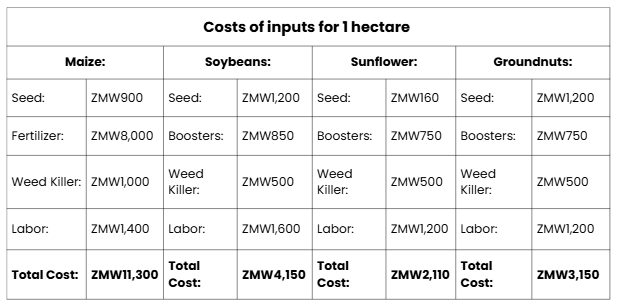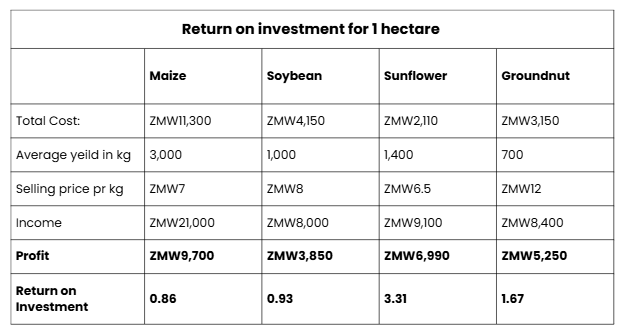Farming Is a Business: Why Profitability Matters
Farming is a business and it can be very tricky to figure out which crops is the most profitable to grow as there is many factors to take into consideration; farm size, soil type, seed prices, fertilizer prices, prices of other inputs and a variable market for the crops. At Monana Organic Limited, we are encouraging farmers to grow sunflowers. Not only do we want to create high-quality products, but we also want to make sure that the crops we use in our production are beneficial for our cooperating farmers. We want the farmers and communities to thrive because agriculture is the backbone of Zambia— and if farmers aren’t making a profit, everyone feels the impact. Here are the reasons why we believe sunflowers are the way to go:
As the rainy season approaches, many farmers find their pockets growing increasingly empty. This is also the time to prepare for a new farming season, which often demands significant investments. Farmers need to secure inputs such as seeds, fertilizer, boosters, pesticides, and sometimes hire labor for land clearing and other tasks.
Sunflower farming not only saves money but also offers higher profit potential, making it a standout choice compared to other common crops in Zambia. Let's break down the numbers to show why sunflowers are a financially wise investment for farmers in Northern Province.
Lower Input Costs = More Money in Your Pocket
Sunflowers require fewer inputs compared to other crops like maize or soybeans. This makes sunflowers an ideal choice if you’re looking to reduce your upfront costs without sacrificing yields and profits. Together with some of our cooperating farmers, we have made some calculations;

Understanding ROI: It’s Not Just About Yield
So the other part for the economics in farming is the profit. Your profit depends on your yield of crops, and how much the buyers are willing to pay which can differ from year to year. So does that mean that the crop that yields the most, is the most profitable? Or does it mean that the crop where you get the most money pr. kg? The answer to both is no, and that is why you should look into the calculation of Return on Investment. Return on Investment measures how much profit you gain compared to what you spend. It’s like asking, “Was this worth it?”

Our 2024/2025 Profit Calculations
Our calculations for the 2024/2025 season, shows that Maize gives the biggest profit for 1 hectare; With a yield of 3,000 kg per hectare and a selling price of 7 Kwacha per kg, maize brings in 21,000 Kwacha in income. But if you used 11,300 Kwatcha to farm 1 hectare of maize then the profit is 9,700 Kwacha - meaning less than the money you put in.
For Sunflower your profit is 6,990 Kwacha looking like less than maize - but it isn't, because you used a lot less money on farming the Sunflower than the maize.
The Return of Investment (ROI) shows that with sunflowers, for every Kwacha you spend, you can expect to earn more than three times your investment back. Compared to other crops, such as maize, which provides less than 1 Kwacha in profit for every Kwacha invested, sunflowers stand out as the most profitable choice. A higher ROI indicates a better return for every Kwacha spent, making sunflower farming a more efficient way to maximize profitability.
These numbers show that sunflower farming offers greater returns for each Kwacha invested, allowing you to make the most of your resources. Lower input costs mean that more of the money earned from sunflower farming stays in your pocket.
A Guaranteed Market with Monana Organic
Another major factor in maximizing profit is having a stable market for your crops. One of the biggest challenges farmers face is uncertainty about selling their harvest, particularly when market prices fluctuate, as is often the case with maize.
We offer a guaranteed market for sunflower farmers in Northern Province, Zambia, with a buying price of 6.5 Kwacha per kg, ensuring you receive fair compensation for your hard work. By partnering with Monana, you can be confident that you will receive a fair market price for your harvest. We hope this stability helps ensure a consistent income, reducing the financial risks associated with farming.
Sunflowers vs. Maize and Soybeans
So when you are planning for the season, we recommend that you compare the costs and returns of different crops. Below is a summary of our calculations for the 2024/2025 season:
- Maize: Total input cost of 11,300 Kwacha and profit of 9,700 Kwacha. ROI is 0.86, which indicates that the returns are limited given the high input costs.
- Soybeans: Total input cost of 4,150 Kwacha and profit of 7,850 Kwacha. ROI is 1.89, meaning that soybeans can be profitable, but require higher management and attention.
- Sunflowers: Total input cost of 2,110 Kwacha and profit of 6,990 Kwacha. ROI is 3.31, making sunflowers a clear winner in terms of profitability and lower financial risk.
How to Get Started with Sunflower Farming
Sunflower farming is an economically sound choice for farmers in Northern Province. With lower input costs, higher returns, and the guaranteed support of Monana Organic Limited, growing sunflowers can help increase profits while minimizing risks. This is a step towards a more secure and prosperous future for you, your families, and your communities.
Ready to take advantage of the economic potential of sunflower farming? Contact Monana Organic Limited today to find out how you can get started.
Interested in growing sunflowers and joining our initiative? Visit our Grow with Us page to learn more about our sunflower initiative and how you can be part of it.